1 Scope
1.1 Scope – Structure of a metadata registry
1.2 Scope – Basic attributes of metadata items
2 Normative references
3 Terms, definitions and abbreviated terms
3.1 Terms and definitions of metamodel constructs used in this part of ISO/IEC 11179
3.2 Terms for concepts used in this part of ISO/IEC 11179
3.3 Abbreviated terms
4 Conformance
4.1 Overview of conformance
4.2 Degree of conformance
4.2.1 General
4.2.2 Strictly conforming implementations
4.2.3 Conforming implementations
4.3 Conformance by clause
4.4 Registry conformance
4.4.1 Overview
4.4.2 Standard profiles for edition 3 registries
4.5 Obligation
4.6 Implementation conformance statement (ICS)
4.7 Roles and responsibilities for registration
5 Structure of a metadata registry
5.1 Metamodel for a metadata registry
5.2 Application of the metamodel
5.3 Specification of the metamodel
5.3.1 Terminology used in specifying the metamodel
5.3.2 Choice of fonts
5.3.3 Use of UML Packages
5.3.4 Package dependencies
5.3.5 Use of UML Class diagrams and textual description
5.4 Types, instances and values
5.5 Types of items in an ISO/IEC 11179 metadata registry
5.5.1 Overview of types of items
5.5.2 Rules for types of items
5.6 Extensibility
5.7 Date references
6 Basic package
6.1 Overview of Basic package
6.2 Basic Types metamodel region
6.2.1 Overview of Basic Types
6.2.2 Boolean datatype
6.2.3 Date datatype
6.2.4 Datetime datatype
6.2.5 Integer datatype
6.2.6 Natural_Range datatype
6.2.7 Notation datatype
6.2.8 Phone_Number datatype
6.2.9 Postal_Address datatype
6.2.10 Sign datatype
6.2.11 String datatype
6.2.12 Text datatype
6.2.13 Value datatype
6.3 Basic Classes metamodel region
6.3.1 Overview of Basic Classes
6.3.2 Contact class
6.3.2.1 Description of Contact
6.3.2.2 Attributes of Contact
6.3.3 Document_Type class
6.3.3.1 Description of Document_Type
6.3.3.2 Attributes of Document_Type
6.3.4 Individual class
6.3.4.1 Description of Individual
6.3.4.2 Attributes of Individual
6.3.5 Language_Identification class
6.3.5.1 Description of Language_Identification
6.3.5.2 Attributes of Language_Identification
6.3.6 Organization class
6.3.6.1 Description of Organization
6.3.6.2 Attributes of Organization
6.3.6.2.5 uri
6.3.7 Reference_Document class
6.3.7.1 Description of Reference_Document
6.3.7.2 Attributes of Reference_Document
6.3.7.2.1 identifier
6.3.7.2.2 type_description
6.3.7.2.3 language_identifier
6.3.7.2.4 notation
6.3.7.2.5 title
6.3.7.2.6 provider
6.3.7.2.7 uri
6.3.8 Registration_Authority_Identifier class
6.3.8.1 Description of Registration_Authority_Identifier
6.3.8.2 Attributes of Registration_Authority_Identifier
6.3.8.2.1 international_code_designator
6.3.8.2.2 organization_identifier
6.3.8.2.3 organization_part_identifier (OPI)
6.3.8.2.4 opi_source
6.3.9 Role class
6.3.9.1 Description of Role
6.3.9.2 Attributes of Role
7 Identification, Designation and Definition package
7.1 Overview of this package
7.2 Identification metamodel region
7.2.1 Overview
7.2.2 Classes in the Identification metamodel region
7.2.2.1 Identified_Item class
7.2.2.2 Scoped_Identifier class
7.2.2.2.1 Description of Scoped_Identifier
7.2.2.2.2 Attributes of Scoped_Identifier
7.2.2.2.2.1 identifer
7.2.2.2.2.2 version
7.2.2.2.2.3 full_expansion
7.2.2.2.2.4 shorthand_expansion
7.2.2.3 Namespace class
7.2.2.3.1 Description of Namespace
7.2.2.3.2 Attributes of Namespace
7.2.2.3.2.1 naming_authority
7.2.2.3.2.2 one_name_per_item_indicator
7.2.2.3.2.3 one_item_per_name_indicator
7.2.2.3.2.4 mandatory_naming_convention_indicator
7.2.2.3.2.5 shorthand_prefix
7.2.2.3.2.6 scheme_reference
7.2.2.4 Slot class
7.2.2.4.1 Description of Slot
7.2.2.4.2 Attributes of Slot
7.2.2.4.2.1 name
7.2.2.4.2.2 type
7.2.2.4.2.3 value
7.2.3 Associations in the Identification metamodel region
7.2.3.1 identification association
7.2.3.2 identifier_scope association
7.2.3.3 item_slot association
7.3 Designation and Definition metamodel region
7.3.1 Overview
7.3.2 Classes in the Designation and Definition metamodel region
7.3.2.1 Acceptability enumeration
7.3.2.2 Designatable_Item class
7.3.2.3 Designation class
7.3.2.3.1 Description of Designation
7.3.2.3.2 Attributes of Designation
7.3.2.3.2.1 sign
7.3.2.3.2.2 language
7.3.2.4 Definition class
7.3.2.4.1 Description of Definition
7.3.2.4.2 Attributes of Definition
7.3.2.4.2.1 text
7.3.2.4.2.2 language
7.3.2.4.2.3 source
7.3.2.5 Context class
7.3.2.6 Namespace class
7.3.2.7 Naming_Convention class
7.3.2.7.1 Description of Naming_Convention
7.3.2.7.2 Attributes of Naming_Convention
7.3.2.7.2.1 scope_rule
7.3.2.7.2.2 authority_rule
7.3.2.7.2.3 semantic_rule
7.3.2.7.2.4 syntactic_rule
7.3.2.7.2.5 lexical_rule
7.3.3 Association Classes in the Designation and Definition metamodel region
7.3.3.1 Definition_Context association class
7.3.3.1.1 Description of Definition_Context
7.3.3.1.2 Attributes of Definition_Context
7.3.3.1.2.1 acceptability
7.3.3.2 Designation_Context association class
7.3.3.2.1 Description of Designation_Context
7.3.3.2.2 Attributes of Designation_Context
7.3.3.2.2.1 acceptability
7.3.4 Associations in the Designation and Definition metamodel region
7.3.4.1 designation_definition_pairing association
7.3.4.2 designation_namespace association
7.3.4.3 item_definition association
7.3.4.4 item_designation association
7.3.4.5 naming_convention_conformance association
7.3.4.6 naming_convention_utilization association
8 Registration package
8.1 Registration metamodel region
8.1.1 Overview
8.1.2 Classes in the Registration region
8.1.2.1 Registered_Item class
8.1.2.1.1 Direct superclass
8.1.2.2 Administered_Item class
8.1.2.2.1 Direct superclass
8.1.2.2.3 Attributes of Administered_Item
8.1.2.2.3.1 creation_date
8.1.2.2.3.2 last_change_date
8.1.2.2.3.3 change_description
8.1.2.2.3.4 explanatory_comment
8.1.2.2.3.5 origin
8.1.2.3 Attached_Item class
8.1.2.3.1 Direct superclass
8.1.2.3.2 Description of Attached_Item
8.1.2.4 Registrar class
8.1.2.4.1 Direct superclass
8.1.2.4.2 Description of Registrar
8.1.2.4.3 Attributes of Registrar
8.1.2.4.3.1 identifier
8.1.2.4.4 Constraint on Registrar
8.1.2.5 Registration_Authority class
8.1.2.5.1 Direct superclass
8.1.2.5.2 Description of Registration_Authority
8.1.2.5.3 Attributes of Registration_Authority
8.1.2.5.3.1 registration_authority_identifier
8.1.2.5.3.2 documentation_language_identifier
8.1.2.6 Registration_State class
8.1.2.6.1 Description of Registration_State
8.1.2.6.2 Attributes of Registration_State
8.1.2.6.2.1 registration_status
8.1.2.6.2.2 effective_date
8.1.2.6.2.3 until_date
8.1.2.6.2.4 administrative_note
8.1.2.6.2.5 unresolved_issue
8.1.2.6.2.6 administrative_status
8.1.2.6.2.7 previous_state
8.1.2.7 Stewardship_Record class
8.1.2.7.1 Description of Stewardship_Record
8.1.2.7.2 Attributes of Stewardship_Record
8.1.2.7.2.1 organization
8.1.2.7.2.2 contact
8.1.2.8 Submission_Record class
8.1.2.8.1 Description of Submission_Record
8.1.2.8.2 Attributes of Submission_Record
8.1.2.8.2.1 organization
8.1.2.8.2.2 contact
8.1.2.9 Registry_Specification class
8.1.2.9.1 Description of Registry_Specification
8.1.2.9.2 Attributes of Registry_Specification
8.1.2.9.2.1.1 name
8.1.2.9.2.2 web_address
8.1.2.9.2.3 standard
8.1.2.9.2.4 conformance_level
8.1.2.9.2.5 character_repertoire
8.1.2.9.2.6 reference_document_identifier_form
8.1.2.9.2.7 primary_language
8.1.2.9.2.8 representation_class_scheme
8.1.2.9.2.9 context
8.1.2.9.2.10 comment
8.1.3 Classes referenced from the Basic package
8.1.3.1 Contact class
8.1.3.2 Organization class
8.1.3.3 Reference_Document class
8.1.4 Classes referenced from the Identification, Designation and Definition package
8.1.4.1 Namespace class
8.1.5 Association Classes in the Registration region
8.1.5.1 Registration association class
8.1.5.1.1 Description of Registration
8.1.5.1.2 Attributes of Registration
8.1.5.1.2.1 registration_state
8.1.5.2 Reference association class
8.1.5.2.1 Description of Reference
8.1.5.2.2 Attributes of Reference
8.1.5.2.2.1 type
8.1.6 Associations in the Registration region
8.1.6.1 attachment association
8.1.6.2 registration_authority_namespace association
8.1.6.3 registration_authority_registrar association
8.1.6.4 stewardship association
8.1.6.5 submission association
9 Concepts package
9.1 Concepts metamodel region
9.1.1 Overview
9.1.2 Classes in the Concepts metamodel region
9.1.2.1 Concept class
9.1.2.2 Concept_System class
9.1.2.2.1 Description of Concept_System
9.1.2.2.2 Attributes of Concept_System
9.1.2.2.2.1 notation
9.1.2.3 Assertion class
9.1.2.3.1 Description of Assertion
9.1.2.3.2 Attributes of Assertion
9.1.2.3.2.1 formula
9.1.2.3.3 Constraint on Assertions
9.1.2.4 Relation class
9.1.2.4.1 Direct superclass
9.1.2.4.2 Description of Relation
9.1.2.4.3 Attributes of Relation
9.1.2.4.3.1 arity
9.1.2.5 Relation_Role class
9.1.2.5.1 Direct superclass
9.1.2.5.2 Description of Relation_Role
9.1.2.5.3 Attributes of Relation_Role
9.1.2.5.3.1 multiplicity
9.1.2.5.3.2 ordinal
9.1.2.6 Link class
9.1.2.6.1 Direct superclass
9.1.2.6.2 Description of Link
9.1.2.6.3 Constraint on Link class
9.1.2.7 Link_End class
9.1.2.7.1 Description of Link_End
9.1.2.7.2 Constraint on Link_End class
9.1.3 Associations of the Concepts metamodel region
9.1.3.1 concept_system_membership association
9.1.3.2 concept_source association
9.1.3.3 concept_system_reference association
9.1.3.4 concept_system_importation association
9.1.3.5 assertion_inclusion association
9.1.3.6 assertion_concept association
9.1.3.7 assertion_predicate association
9.1.3.8 relation_link association
9.1.3.9 relation_role_set association
9.1.3.10 link_has_link_end association
9.1.3.11 link_end_concept association
9.1.3.12 link_end_role association
9.2 Classification metamodel region
9.2.1 Overview
9.2.2 Classes in the Classification metamodel region
9.2.2.1 Classifiable_Item class
9.2.2.2 Concept_System class
9.2.2.3 Concept class
9.2.3 Associations Classes in the Classification metamodel region
9.2.3.1 Classification association class
9.2.4 Associations in the Classification metamodel region
9.2.4.1 classification_scheme association
9.2.4.2 concept_system_membership association
10 Binary Relations package
10.1 Binary Relations metamodel region
10.1.1 Overview
10.1.2 Classes in the Binary_Relations metamodel region
10.1.2.1 Relation class
10.1.2.2 Binary_Relation class
10.1.2.2.1 Direct superclass
10.1.2.2.2 Description of Binary_Relation
10.1.2.2.3 Attributes of Binary_Relation
10.1.2.2.3.1 reflexivity
10.1.2.2.3.2 symmetry
10.1.2.2.3.3 transitivity
10.1.2.3 Reflexivity enumeration
10.1.2.4 Symmetry enumeration
10.1.2.5 Transitivity enumeration
11 Data Description package
11.1 High-level Data Description metamodel region
11.1.1 Overview
11.1.2 Classes of High-level Data Description metamodel
11.1.2.1 Overview
11.1.2.2 Conceptual_Domain class
11.1.2.2.1 Direct superclass
11.1.2.2.2 Description of Conceptual_Domain
11.1.2.3 Value_Domain class
11.1.2.4 Data_Element class
11.1.2.5 Data_Element_Concept class
11.1.2.5.1 Direct superclass
11.1.2.5.2 Description of Data_Element_Concept
11.1.3 Associations of the High Level Data Description metamodel
11.1.3.1 value_domain_meaning association
11.1.3.2 data_element_domain association
11.1.3.3 data_element_meaning association
11.1.3.4 data_element_concept_domain association
11.1.4 Constraints of the High Level Metamodel
11.1.4.1 Equality of mappings from data element to conceptual domain
11.2 Data Element Concept metamodel region
11.2.1 Overview
11.2.2 Classes in the Data_Element_Concept region
11.2.2.1 Object_Class class
11.2.2.1.1 Direct superclass
11.2.2.1.2 Description of Object_Class
11.2.2.2 Property class
11.2.2.2.1 Direct superclass
11.2.2.2.2 Description of Property
11.2.2.3 Data_Element_Concept class
11.2.2.3.1 Direct superclass
11.2.2.3.2 Description of Data_Element_Concept
11.2.2.4 Conceptual_Domain class
11.2.3 Associations in the Data_Element_Concept region
11.2.3.1 data_element_concept_property association
11.2.3.2 data_element_concept_domain association
11.2.3.3 data_element_concept_object_class association
11.3 Conceptual and Value_Domain metamodel region
11.3.1 Overview
11.3.2 Classes in the Conceptual and Value_Domain region
11.3.2.1 Conceptual_Domain class
11.3.2.1.1 Direct superclass
11.3.2.1.2 Description of Conceptual_Domain
11.3.2.1.3 Attributes of Conceptual_Domain
11.3.2.1.3.1 dimensionality
11.3.2.2 Enumerated_Conceptual_Domain class
11.3.2.2.1 Direct superclass
11.3.2.2.2 Description of Enumerated_Conceptual_Domain
11.3.2.3 Value_Meaning class
11.3.2.3.1 Direct superclass
11.3.2.3.2 Description of Value_Meaning
11.3.2.3.3 Attributes of Value_Meaning
11.3.2.3.3.1 begin_date
11.3.2.3.3.2 end_date
11.3.2.4 Described_Conceptual_Domain class
11.3.2.4.1 Direct superclass
11.3.2.4.2 Description of Described_Conceptual_Domain
11.3.2.4.3 Attributes of Described_Conceptual_Domain
11.3.2.4.3.1 description
11.3.2.5 Value_Domain class
11.3.2.5.1 Description of Value_Domain
11.3.2.5.2 Attributes of Value_Domain
11.3.2.5.2.1 datatype
11.3.2.5.2.2 format
11.3.2.5.2.3 maximum_character_quantity
11.3.2.5.2.4 unit_of_measure
11.3.2.6 Enumerated_Value_Domain class
11.3.2.6.1 Direct superclass
11.3.2.6.2 Description of Enumerated_Value_Domain
11.3.2.7 Permissible_Value class
11.3.2.7.1 Description of Permissible_Value
11.3.2.7.2 Attributes of Permissible_Value
11.3.2.7.2.1 permitted_value
11.3.2.7.2.2 begin_date
11.3.2.7.2.3 end_date
11.3.2.7.3 Example of Permissible_Values
11.3.2.8 Described_Value_Domain class
11.3.2.8.1 Direct superclass
11.3.2.8.2 Description of Described_Value_Domain
11.3.2.8.3 Attributes of Described_Value_Domain
11.3.2.8.3.1 description
11.3.2.9 Datatype class
11.3.2.9.1 Description of Datatype
11.3.2.9.2 Attributes of Datatype
11.3.2.9.2.1 name
11.3.2.9.2.2 description
11.3.2.9.2.3 scheme_reference
11.3.2.9.2.4 annotation
11.3.2.9.3 Examples of Datatypes
11.3.3 Associations in the Conceptual and Value_Domain region
11.3.3.1 value_domain_meaning association
11.3.3.2 value_meaning_set association
11.3.3.3 described_value_domain_meaning association
11.3.3.4 permissible_value_meaning association
11.3.3.5 permissible_value_set association
11.3.3.6 value_domain_subset association
11.3.4 Additional Constraints of the Conceptual and Value_Domain region
11.3.4.1 Overview
11.3.4.2 value_domain_meaning association constraints
11.3.4.3 value_domain_subset association constraints
11.3.4.4 Consistent dimensionalities
11.4 Measurement metamodel region
11.4.1 Overview
11.4.2 Classes in the Measurement region
11.4.2.1 Unit_of_Measure class
11.4.2.1.1 Direct superclass
11.4.2.1.2 Description of Unit_of_Measure
11.4.2.2 Measure_Class class
11.4.2.2.1 Description of Measure_Class
11.4.2.3 Dimensionality class
11.4.2.3.1 Direct superclass
11.4.2.3.2 Description of Dimensionality
11.4.2.3.3 Attributes of Dimensionality
11.4.2.3.3.1 coordinate_indicator
11.4.3 Associations in the Measurement region
11.4.3.1 dimensionality_measure_class association
11.4.3.2 unit_of_measure_class association
11.5 Data_Element metamodel region
11.5.1 Overview
11.5.2 Classes in the Data_Element Region
11.5.2.1 Data_Element class
11.5.2.1.1 Description of Data_Element
11.5.2.1.2 Attributes of Data_Element
11.5.2.1.2.1 data_element_precision
11.5.2.2 Data_Element_Concept class
11.5.2.3 Value_Domain class
11.5.2.4 Data_Element_Example class
11.5.2.4.1 Description of Data_Element_Example
11.5.2.4.2 Attributes of Data_Element_Example
11.5.2.4.2.1 example_item
11.5.2.5 Derivation_Rule class
11.5.2.5.1 Description of Derivation_Rule
11.5.2.5.2 Attributes of Derivation_Rule
11.5.2.5.2.1 derivation_rule_specification
11.5.2.5.2.2 derivation_rule_notation
11.5.2.5.3 Example of Derivation_Rule
11.5.2.6 Data_Element_Derivation class
11.5.3 Associations in the Data_Element region
11.5.3.1 data_element_domain association
11.5.3.2 data_element_meaning association
11.5.3.3 exemplification association
11.5.3.4 derivation_input association
11.5.3.5 derivation_output association
11.5.3.6 derivation_rule_application association
11.6 Consolidated Data Description Metamodel
11.7 Types of Concepts in the Data Description Metamodel
12 Basic attributes
12.1 Use of basic attributes
12.2 Common attributes
12.2.1 Identifying
12.2.2 Naming
12.2.3 Definitional
12.2.4 Administrative
12.2.5 Relational
12.3 Attributes specific to Data_Element_Concepts
12.4 Attributes specific to Data_Elements
12.5 Attributes specific to Conceptual_Domains
12.6 Attributes specific to Value_Domains
12.7 Attributes specific to Permissible_Values
12.8 Attributes specific to Value_Meanings
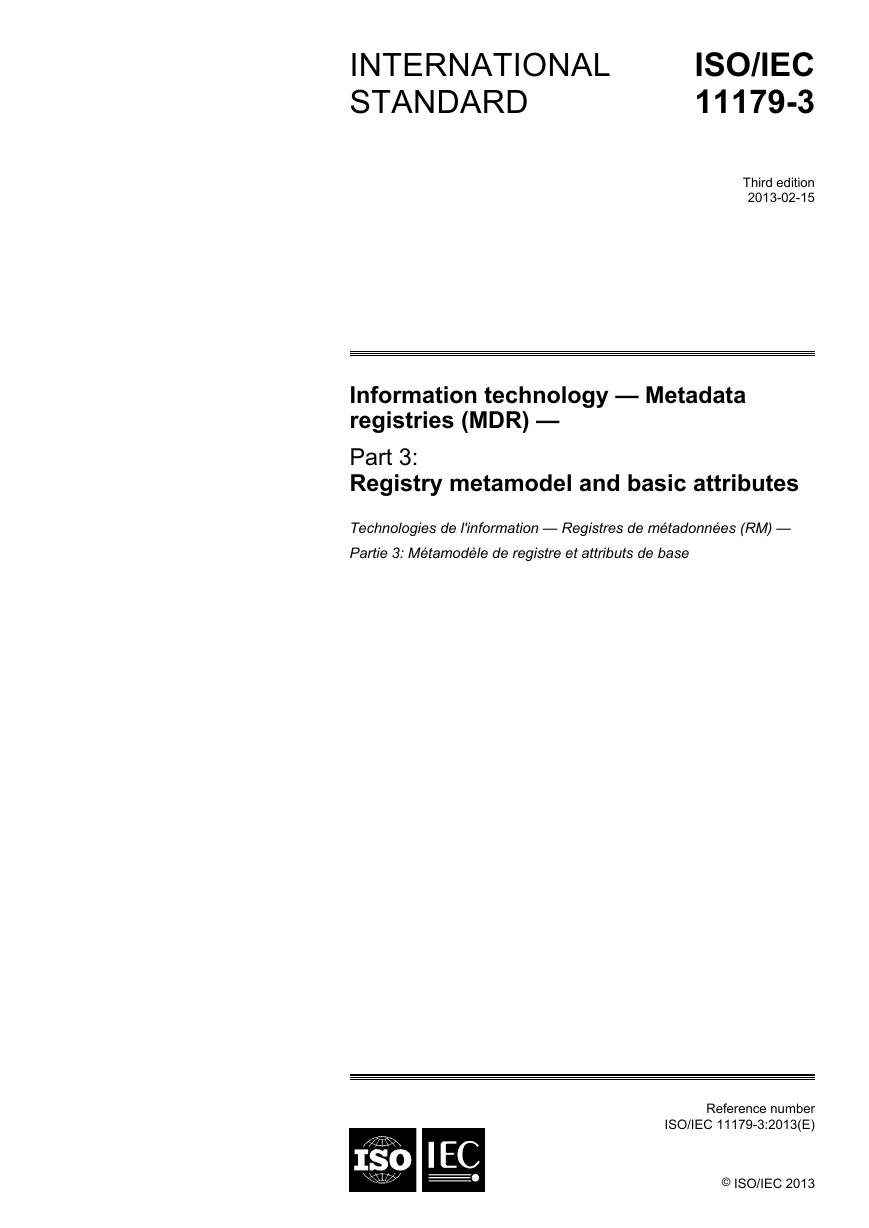
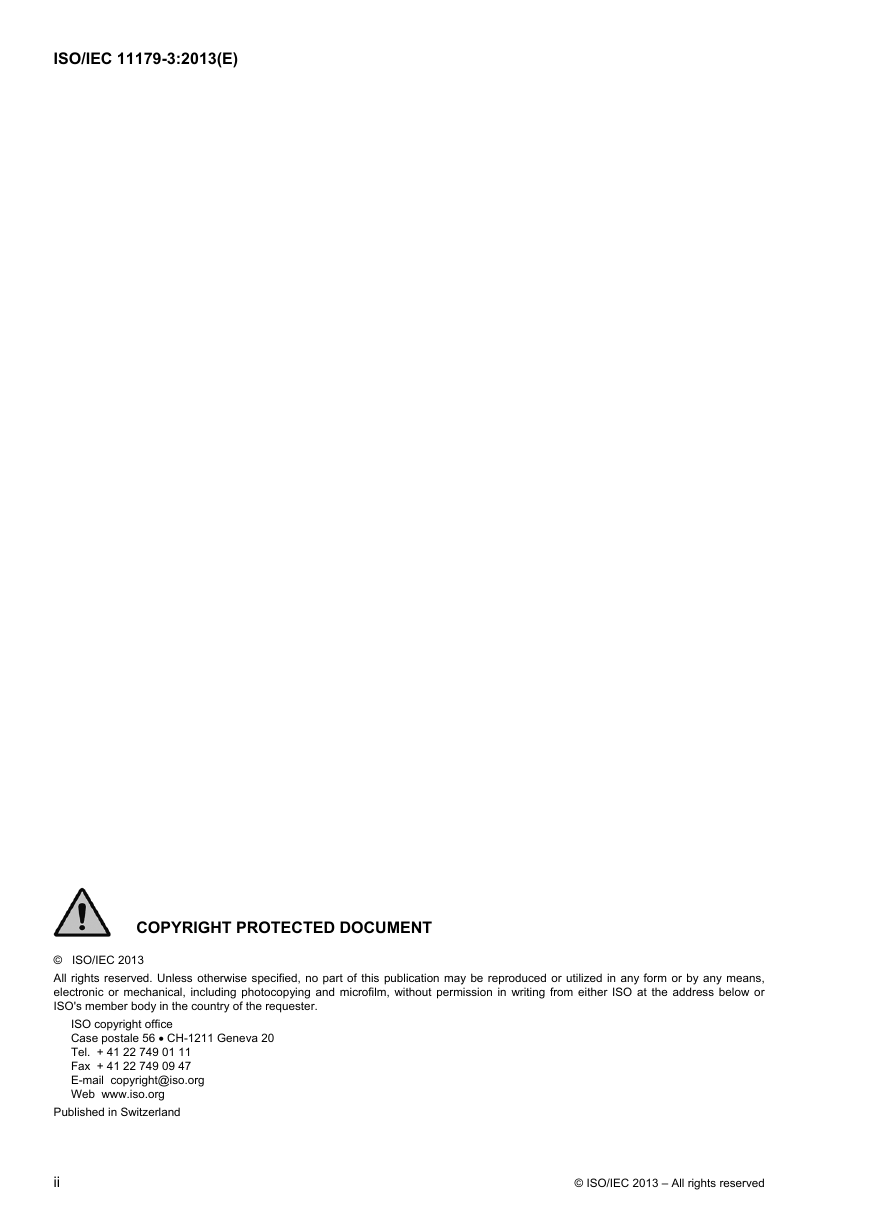
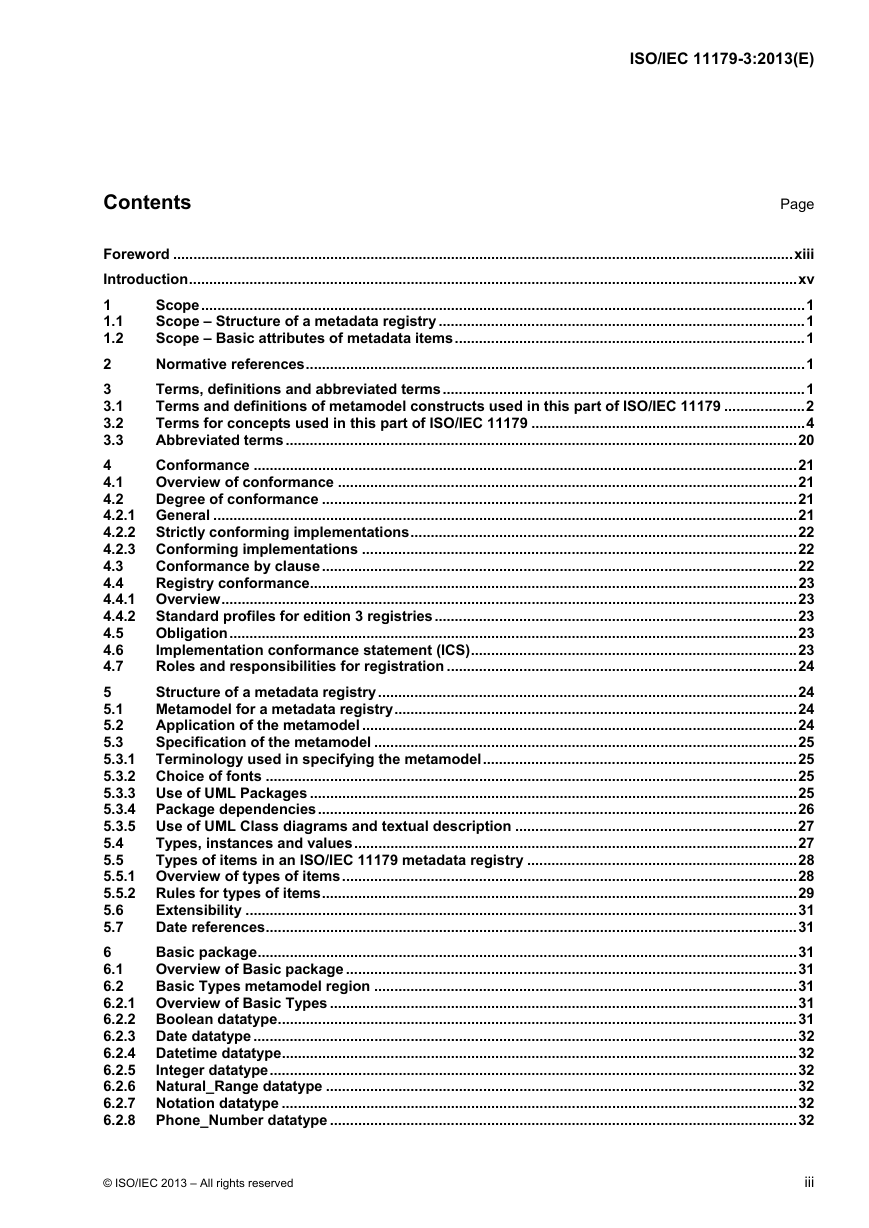
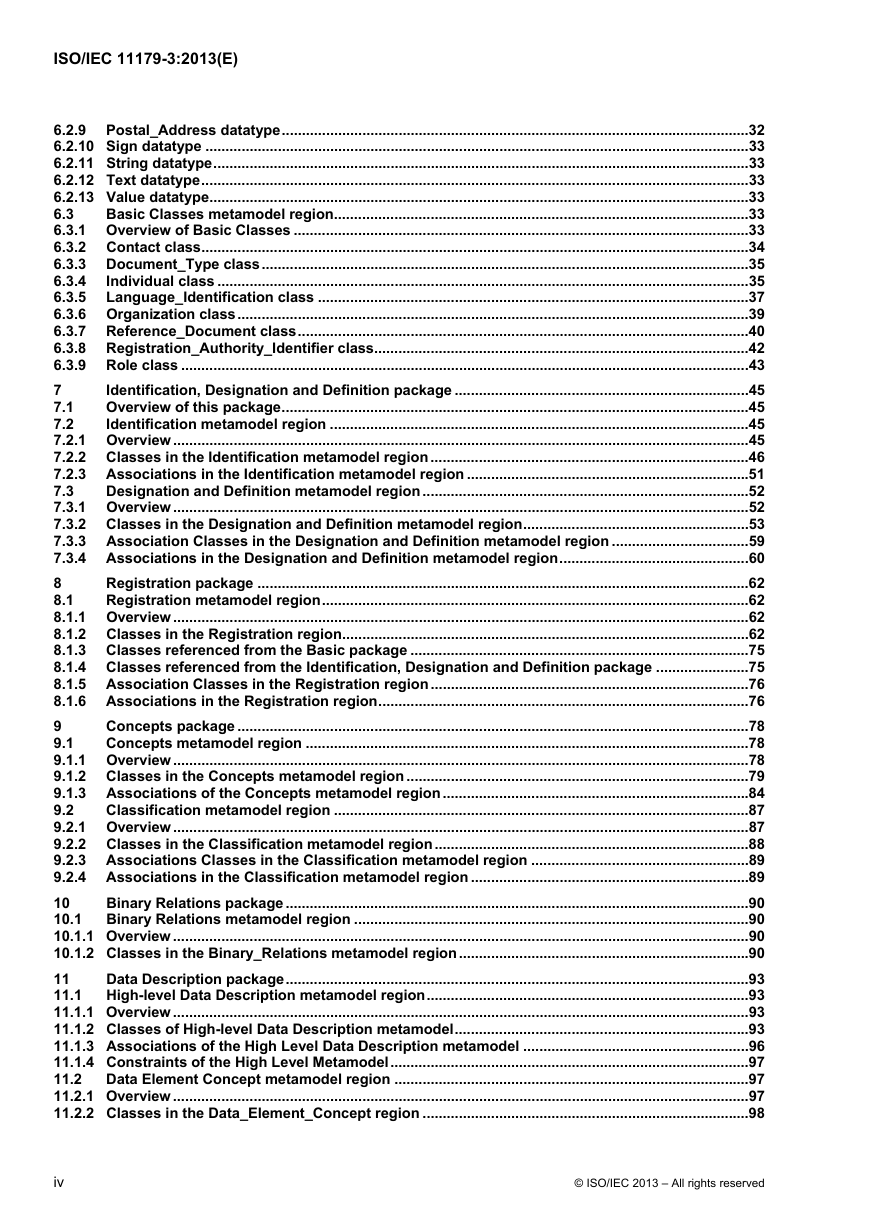
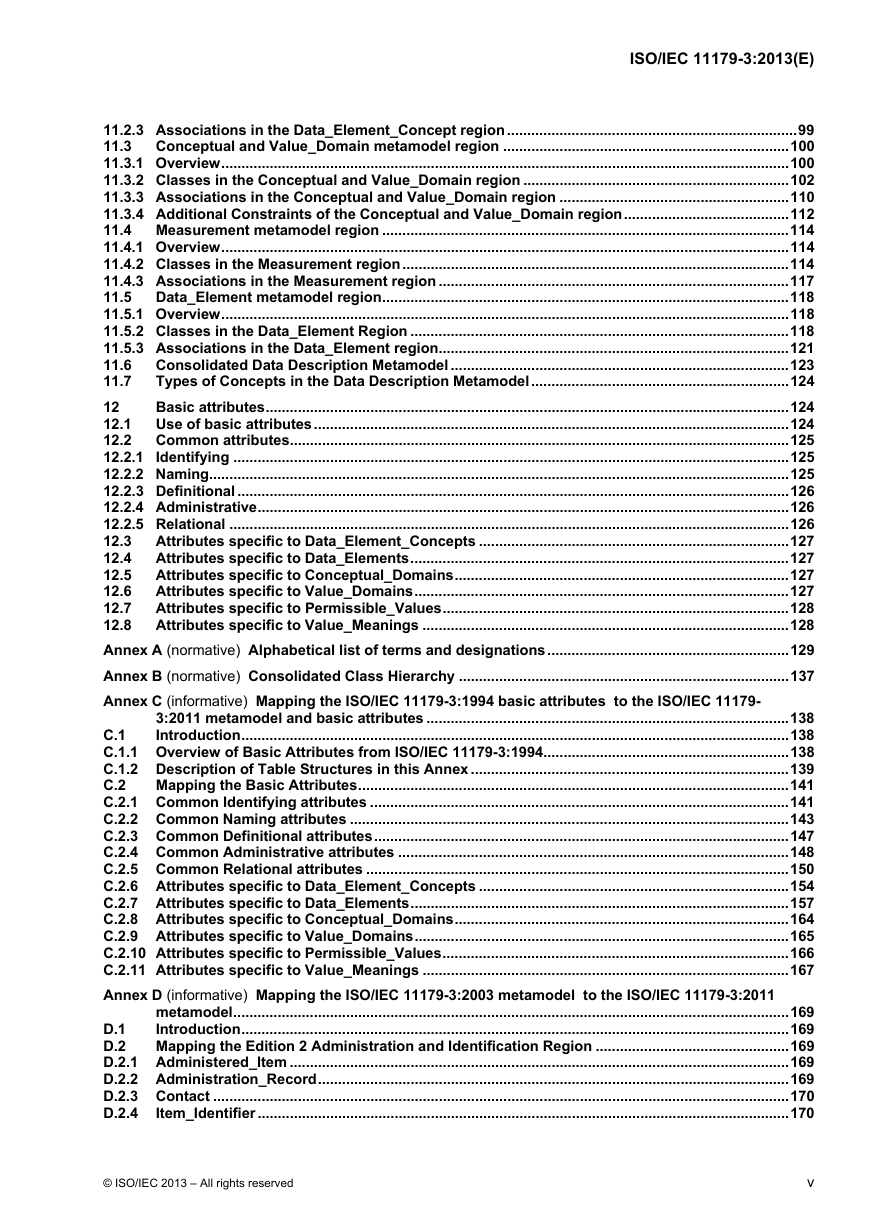
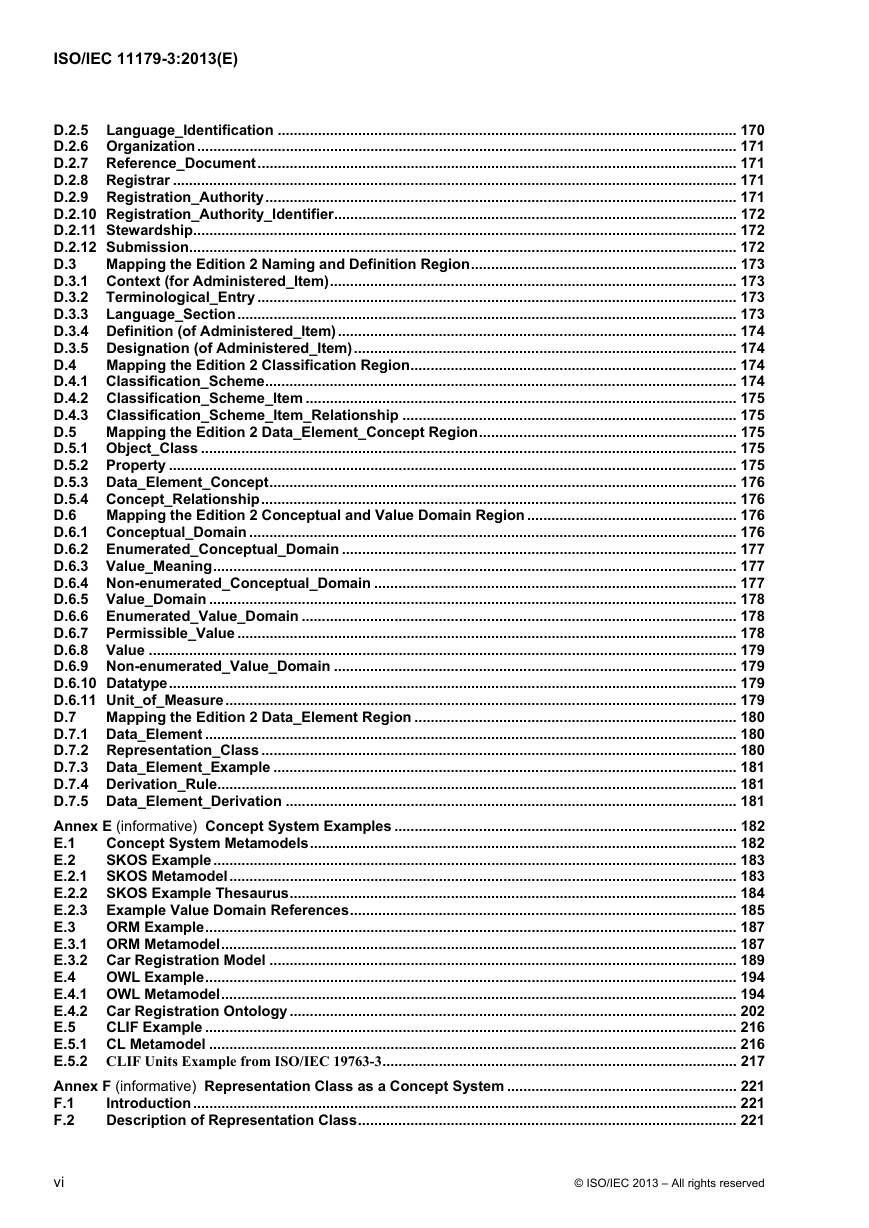
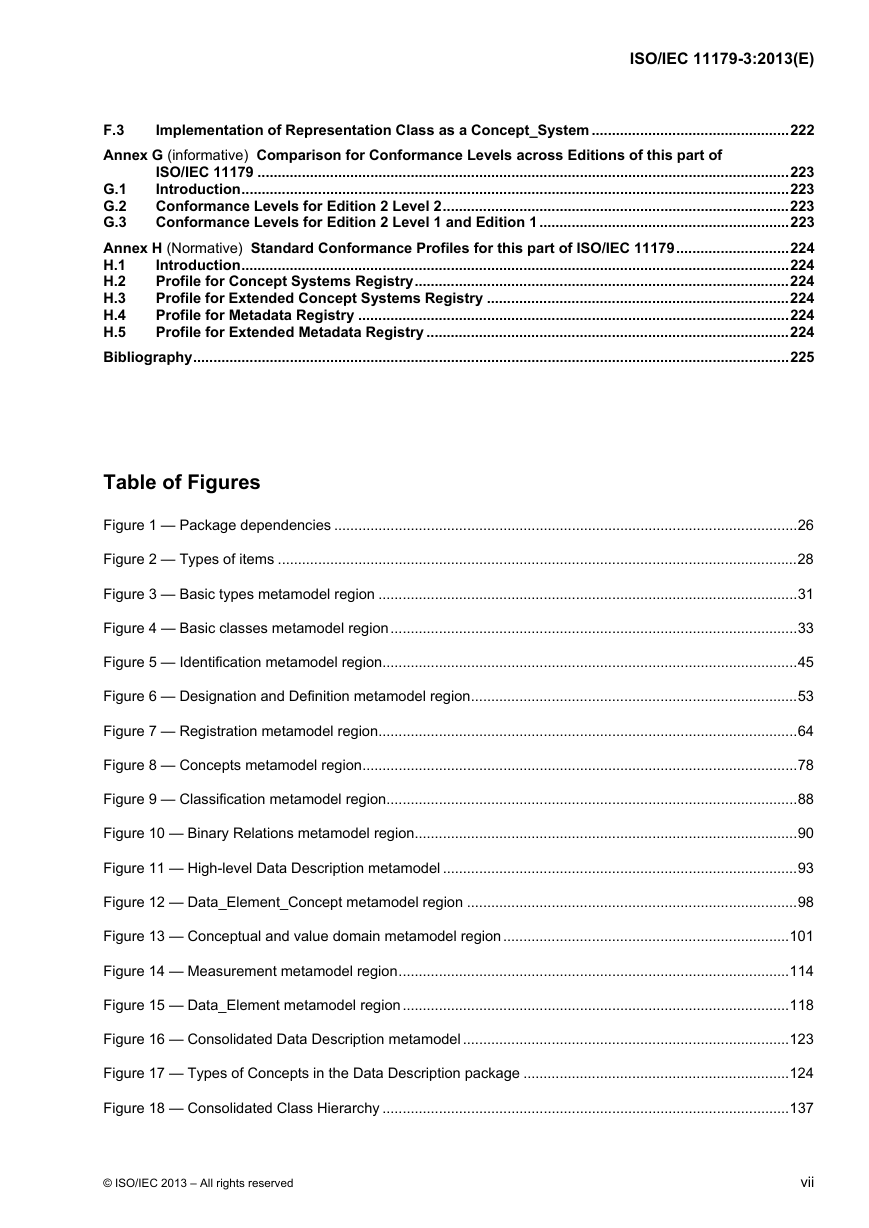
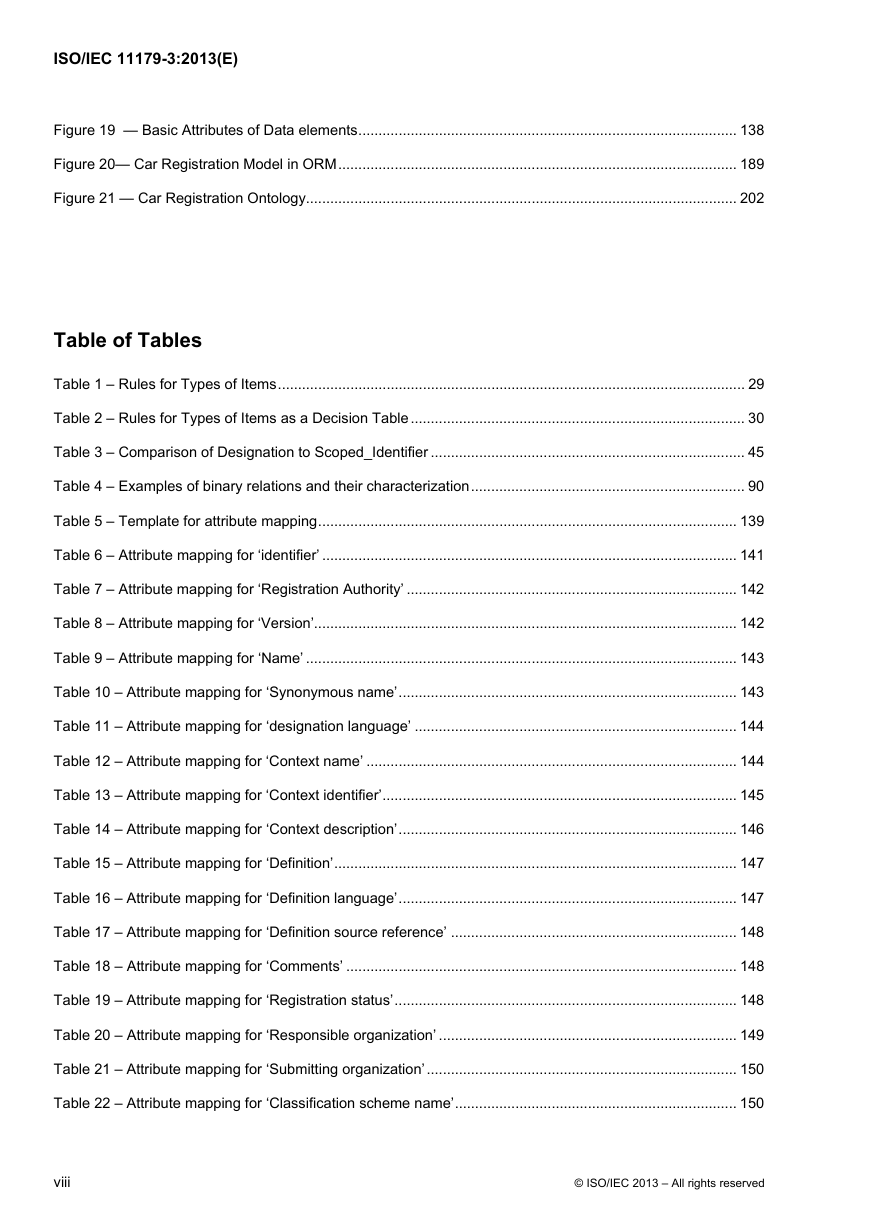








 2023年江西萍乡中考道德与法治真题及答案.doc
2023年江西萍乡中考道德与法治真题及答案.doc 2012年重庆南川中考生物真题及答案.doc
2012年重庆南川中考生物真题及答案.doc 2013年江西师范大学地理学综合及文艺理论基础考研真题.doc
2013年江西师范大学地理学综合及文艺理论基础考研真题.doc 2020年四川甘孜小升初语文真题及答案I卷.doc
2020年四川甘孜小升初语文真题及答案I卷.doc 2020年注册岩土工程师专业基础考试真题及答案.doc
2020年注册岩土工程师专业基础考试真题及答案.doc 2023-2024学年福建省厦门市九年级上学期数学月考试题及答案.doc
2023-2024学年福建省厦门市九年级上学期数学月考试题及答案.doc 2021-2022学年辽宁省沈阳市大东区九年级上学期语文期末试题及答案.doc
2021-2022学年辽宁省沈阳市大东区九年级上学期语文期末试题及答案.doc 2022-2023学年北京东城区初三第一学期物理期末试卷及答案.doc
2022-2023学年北京东城区初三第一学期物理期末试卷及答案.doc 2018上半年江西教师资格初中地理学科知识与教学能力真题及答案.doc
2018上半年江西教师资格初中地理学科知识与教学能力真题及答案.doc 2012年河北国家公务员申论考试真题及答案-省级.doc
2012年河北国家公务员申论考试真题及答案-省级.doc 2020-2021学年江苏省扬州市江都区邵樊片九年级上学期数学第一次质量检测试题及答案.doc
2020-2021学年江苏省扬州市江都区邵樊片九年级上学期数学第一次质量检测试题及答案.doc 2022下半年黑龙江教师资格证中学综合素质真题及答案.doc
2022下半年黑龙江教师资格证中学综合素质真题及答案.doc